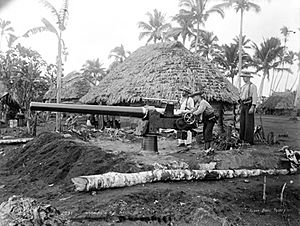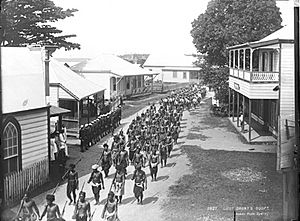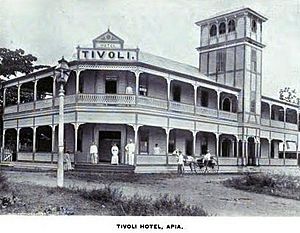Siege of Apia facts for kids
Quick facts for kids Siege of Apia |
|||||||
|---|---|---|---|---|---|---|---|
| Part of the Second Samoan Civil War | |||||||
 United States Marines manning a naval gun near Apia in March of 1899. |
|||||||
|
|||||||
| Belligerents | |||||||
| Allies: |
Supported by: |
||||||
| Commanders and leaders | |||||||
| Strength | |||||||
| Land: 2,260 Sea: 3 cruisers 1 corvette |
4,000 | ||||||
| Casualties and losses | |||||||
| 9 killed 10-15 wounded |
~27 killed | ||||||
The Siege of Apia was an important battle during the Second Samoan Civil War. It happened in March 1899 in Apia, a town in Samoa. In this battle, Samoan fighters who supported Malietoa Tanumafili I were surrounded by a larger group of Samoan rebels. These rebels were loyal to Mata'afa Iosefo.
To help Malietoa, soldiers and sailors from four British and American warships joined the fight. After several days of intense fighting, the rebel forces were defeated.
Contents
Why the Siege Happened
Followers of Mata'afa Iosefo were getting help from Germany. In January 1899, the Mataafans forced Malietoa Tanumafili I to leave Samoa. This made the United States Navy and the Royal Navy (Britain's navy) get involved.
On March 13, Rear Admiral Albert Kautz arrived on the American warship USS Philadelphia. He tried to find a peaceful solution by meeting with different officials. When no agreement was reached, American and British troops landed on shore. They told Mataafa's followers to leave Apia and go back to their villages.
Instead of obeying, the Mataafans moved to the edges of town. They began forcing European and American people out of their homes. These people then fled into Apia for safety. They stayed in houses along the coast, protected by the big guns of the warships. The British warships HMS Porpoise and HMS Royalist also came to Apia. Their sailors and marines landed to help protect the town.
The Siege Begins
On March 15, Admiral Kautz sent another message to Mataafa. He demanded that the Mataafans leave the outskirts of Apia. But Mata'afa Iosefo ignored this order. Instead, he brought even more fighters to surround Apia and then attacked.
British and American commanders believed there were over 4,000 rebel warriors. They had about 2,500 rifles. About 260 British and American service members were involved in the siege. They fought alongside about 2,000 friendly Samoan warriors. Apia was the main town, surrounded by several smaller villages.
The Americans used the Tivoli Hotel in Apia as their command center. Guards were also placed at the consulates (offices for foreign officials). These buildings were quite isolated and surrounded by thick jungle.
First Attacks
At 12:30 AM, Mataafan fighters rushed the British and American consulates. Sailors and marines guarded these buildings. They were led by Lieutenant Guy Reginald Archer Gaunt from HMS Porpoise and Captain M. Perkins of the United States Marines. The British and Americans held their fire. The Samoans retreated when they realized Apia's defenders were ready for battle.
Just before 1:00 PM, rebel boats were seen near Vaiusu. It was thought they were planning to attack Samoan refugees in Mulinuu village. When Kautz heard about the attack on the consulates, he ordered his ships to fire. All three British and American warships began shelling the boats and the edges of Apia. They continued until 5:00 PM. Then, HMS Porpoise went alone to shell the villages of Vaiusu and Vaimoso. Several boats were sunk that day, and many shells were fired.
Fighting at the Hotel
The Mataafans decided to attack the American-held Tivoli Hotel on the night of March 15. During this attack, the Samoan rebels rushed forward quickly. They briefly captured a 7-pounder artillery gun. However, they were pushed back by fire from both the soldiers inside and the warships. One American guard was killed, along with three British soldiers. The number of Samoan casualties is not known.
From that point until the end of the siege, the fighting mostly involved sniping and small skirmishes. Mataafa's army continued to hold the outskirts of Apia and many nearby villages. The Allied forces decided they needed to combine their strength. They planned to attack Mataafa's main lines. They hoped a big battle would force the rebels to give up the siege.
Final Push
On March 24, the British warship HMS Tauranga arrived in Apia. Captain Leslie Creery Stuart was in charge of this ship. He then took command of all British naval operations in Samoa.
The final major fight happened on March 30. British, American, and Samoan loyalist forces marched south to face Mataafa. Three miles south of Apia, the Allies, led by Lieutenant Gault, attacked a large rebel force. They defeated them. Twenty-seven Mataafan fighters were killed. The Allies lost three more British soldiers, one American sailor, and one Samoan warrior. Several others were wounded. After this defeat, the rebels retreated to their main base at Vailele, southeast of Apia. During the siege, the German consulate was hit by shells. Its occupants later complained about the American and British use of force in Samoa.
What Happened Next
After the Siege of Apia, the Samoan loyalists, British, and Americans began operations against Vailele. On April 1, about 250 men went to Vailele. HMS Royalist supported them. They burned two villages along the way. The Royalist also shelled Vailele's defenses. But when the group got close to the town, a larger force of Mataafans attacked them by surprise and won.
On March 13, the rebels attacked the British and Samoan front line outside Vailele. In this battle, the Mataafans were pushed back. On March 17, the Allies fought at Vailele for the third and final time. British and Samoan loyalists, with help from a small group of Americans, captured one of the two forts at Vailele. However, they were soon forced to retreat. During this action, USS Philadelphia and the British warships shelled the port.
The third battle at Vailele was the last big fight of the war. After it, the Allies said that as long as the Mataafans stayed out of Apia, they would not attack them. One more small fight happened on April 25. Mataafans attacked an American marine patrol outside Apia, but the rebels were driven away.
See also



